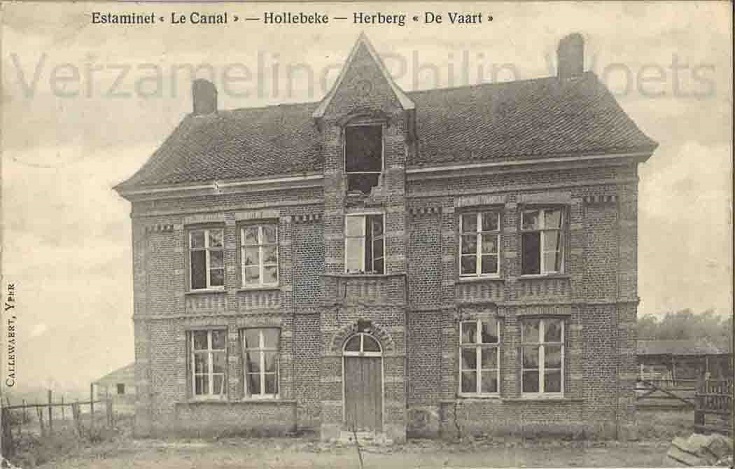Around July 1913, it became clear that all was not well with the newly erected bridge over the troublesome canal. Due to unstable subsoil, the bridge pillars were moving and the bridge was too rigid to tolerate the stresses. For the denizens of the hamlet of Bernikkewallehoek gathered in their café ‘In de Vaart‘, this would have been no surprise. Already another of their grander buildings had had to be demolished as it was too close to the subsiding sides of the canal. Now the café itself began to share the same fate.
Looking at the image of the café, nothing is straight anymore as the stresses of subsidence overwhelm the structure.
By the time the World War ground to a halt at this very place in October 1914, ‘In de Vaart’ was gone too, removed for the value of its materials before it was too late. Gone too was Bernikkewallehoek, where nobody would remain with the ground loose under their feet.
In 1940, again a World War briefly visited the canal, a natural defensive line against an enemy arriving from East to West.

On 27th May 1940 the German invaders had pushed the 2nd Royal Scots Fusiliers battalion back from their position at Hill 60, and the last to evacuate this position and retreat behind the canal were the Bren carriers of D Company. The fate of the last of these vehicles, as it attempted to cross from one side to the other under fire from the advanced parties of Germans, is described by Jacques Crossart, then owner of the new chateau, now the clubhouse of the golf course:-
The retreat takes place through the woods in good order, whilst the Bren gun carriers form a rear guard, protecting them like loyal dogs. The last carrier is now on the road back to the collapsed bridge, its mission finished it accelerates to top speed. It goes past the burning convoy and across the fields and down the slope. It heads down to the ford (………..), its caterpillar tracks losing grip on the loose stones, the tracks then bite the mud on the bank and it begins to rise again. They have almost made it; however, the Jägers have finally seen it from their positions along the base of the Bluff. A burst of machine gun fire hits the driver, the carrier zig zags into the old bridge structure; it swerves, overturns and catches fire.
If you have any interest in the brief but intense confrontation in the Palingbeek on the fateful days of May 1940, you can do no better than read these pages: Iain Miskimmin presents The 2nd Battalion Royal Scots Fusiliers in 1940.

